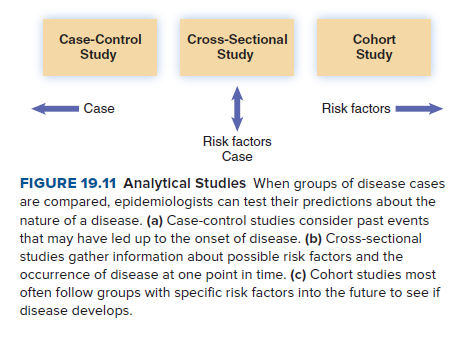Cross-Sectional Study Case-Control Cohort Study Study Case Risk factors Risk factors Case FIGURE 19.11 Analytical Studies When groups of disease cases are compared, epidemiologists can test their predictions about the nature of a disease. (a) Case-control studies consider past events that may have led up to the onset of disease. (b) Cross-sectional studies gather information about possible risk factors and the occurrence of disease at one point in time. (c) Cohort studies most often follow groups with specific risk factors into the future to see if disease develops.
Cross-Sectional Study Case-Control Cohort Study Study Case Risk factors Risk factors Case FIGURE 19.11 Analytical Studies When groups of disease cases are compared, epidemiologists can test their predictions about the nature of a disease. (a) Case-control studies consider past events that may have led up to the onset of disease. (b) Cross-sectional studies gather information about possible risk factors and the occurrence of disease at one point in time. (c) Cohort studies most often follow groups with specific risk factors into the future to see if disease develops.
Human Anatomy & Physiology (11th Edition)
11th Edition
ISBN:9780134580999
Author:Elaine N. Marieb, Katja N. Hoehn
Publisher:Elaine N. Marieb, Katja N. Hoehn
Chapter1: The Human Body: An Orientation
Section: Chapter Questions
Problem 1RQ: The correct sequence of levels forming the structural hierarchy is A. (a) organ, organ system,...
Related questions
Question
In a case-control study, how do the cases differ from the controls?

Transcribed Image Text:Cross-Sectional
Study
Case-Control
Cohort
Study
Study
Case
Risk factors
Risk factors
Case
FIGURE 19.11 Analytical Studies When groups of disease cases
are compared, epidemiologists can test their predictions about the
nature of a disease. (a) Case-control studies consider past events
that may have led up to the onset of disease. (b) Cross-sectional
studies gather information about possible risk factors and the
occurrence of disease at one point in time. (c) Cohort studies most
often follow groups with specific risk factors into the future to see if
disease develops.
Expert Solution
This question has been solved!
Explore an expertly crafted, step-by-step solution for a thorough understanding of key concepts.
This is a popular solution!
Trending now
This is a popular solution!
Step by step
Solved in 2 steps

Knowledge Booster
Learn more about
Need a deep-dive on the concept behind this application? Look no further. Learn more about this topic, biology and related others by exploring similar questions and additional content below.Recommended textbooks for you

Human Anatomy & Physiology (11th Edition)
Biology
ISBN:
9780134580999
Author:
Elaine N. Marieb, Katja N. Hoehn
Publisher:
PEARSON

Biology 2e
Biology
ISBN:
9781947172517
Author:
Matthew Douglas, Jung Choi, Mary Ann Clark
Publisher:
OpenStax

Anatomy & Physiology
Biology
ISBN:
9781259398629
Author:
McKinley, Michael P., O'loughlin, Valerie Dean, Bidle, Theresa Stouter
Publisher:
Mcgraw Hill Education,

Human Anatomy & Physiology (11th Edition)
Biology
ISBN:
9780134580999
Author:
Elaine N. Marieb, Katja N. Hoehn
Publisher:
PEARSON

Biology 2e
Biology
ISBN:
9781947172517
Author:
Matthew Douglas, Jung Choi, Mary Ann Clark
Publisher:
OpenStax

Anatomy & Physiology
Biology
ISBN:
9781259398629
Author:
McKinley, Michael P., O'loughlin, Valerie Dean, Bidle, Theresa Stouter
Publisher:
Mcgraw Hill Education,

Molecular Biology of the Cell (Sixth Edition)
Biology
ISBN:
9780815344322
Author:
Bruce Alberts, Alexander D. Johnson, Julian Lewis, David Morgan, Martin Raff, Keith Roberts, Peter Walter
Publisher:
W. W. Norton & Company

Laboratory Manual For Human Anatomy & Physiology
Biology
ISBN:
9781260159363
Author:
Martin, Terry R., Prentice-craver, Cynthia
Publisher:
McGraw-Hill Publishing Co.

Inquiry Into Life (16th Edition)
Biology
ISBN:
9781260231700
Author:
Sylvia S. Mader, Michael Windelspecht
Publisher:
McGraw Hill Education